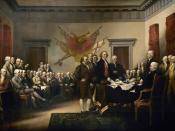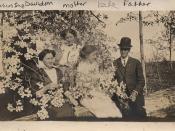Economic GrowthIn 1801 Thomas Jefferson became the third president of the United States. During his first term he sought to acquire full access to the Mississippi River and to expand settlement into the west. This decision not only doubled the size of the nation, 827,000 square miles, but also insured that products from the rich farming regions of the mid-west could travel down the river to New Orleans. Jefferson arranged for the Louisiana Purchase from France in 1803 for $15 million, a legendary real estate deal, (Wilson, 2003). During the years between 1819 and 1837 were crucial to the growth of the American economy. This was the time of the western expansion to new territories for development. With a chance to prosper from new land early settlers migrated out west. During this time, an increase in resources, new inventions, capital investments, and automation of materials brought a vivid shift in the nonagricultural economy.
About 79% of Americans were connected to agriculture in 1820. However, only 55% continued in agriculture in 1850. At the same time, agriculture flourished in the south and moved to the west. The world's demand for cotton grew; 15.5 cents per pound in 1835 and 15.2 cents per pound in 1836, (connerprairie, 2007). By 1850, 80% of the world's cotton was grown in the south, (usinfo, 2005). Another factor to economic growth, in the 19th century, would have contributed by improvements of transportation of material. Between the years of 1814 and 1834, steamboats travels increased from 20 to 1200 a year. Robert Fulton's invention of the steamboat stimulated the growth of the agriculture economy by transporting agriculture and industrial supplies faster and cheaper, (Bellis, 2007). The manifestation of the large railroad system, better roads, the Erie Canal, and Ohio's canal system all affected the economy as...


